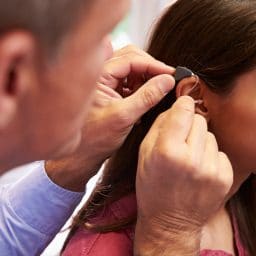Hearing aids come in a wide variety of shapes, styles and colors. Unfortunately, you can’t try on every set like you would a pair of jeans at Citadel Mall to find the perfect fit. Instead, you’ll work with an expert audiologist to figure out what hearing aid is best suited to your hearing needs, lifestyle, aesthetic and budget.
Below is an overview of each step of the fitting process.
Get a Hearing Test to Determine Your Type of Hearing Loss
After you get a hearing test, the results will be charted on an audiogram, which is essentially a visual representation of what sounds you can hear at each frequency range. Certain hearing aids are not suitable for certain types or degrees of hearing loss, so this step is very important. For example, completely-in-the-canal (CIC) hearing aids are not quite powerful enough for people with more severe hearing loss.
Consider Your Lifestyle Needs
Hearing aids are available with many different levels of technology at many different price points. If you spend most of your days at home doing quiet activities, you won’t need as many hearing aid features as somebody who works in a courtroom, even if you have the same degree of hearing loss. Budgetary constrictions also come into play when selecting a hearing aid.
Physical Fit
Just as important as getting the technology right is making sure your hearing aids physically fit; a hearing aid is useless if it’s too uncomfortable to wear. Your audiologist will measure your ears to determine how long the tubing/wiring needs to be for behind-the-ear (BTE) hearing aids, and impressions may need to be taken so that the earmolds or in-the-ear (ITE) hearing aids fit properly.
Programming Your Hearing Aid
At the fitting appointment, your audiologist will program your hearing aids to the exact specification of your hearing loss by amplifying sounds that are too soft and setting volume limits so that no incoming sounds are too loud.
Your audiologist may also conduct a real ear measurement, which is performed by placing a thin tube connected to a microphone into the ear canal to measure the volume of sounds near your eardrum. Then they will place your hearing aid and measure sounds as they’re filtered through to ensure you can hear incoming sounds comfortably.
Follow-up
Hearing aid fitting is both an art and a science, so it may take some time to get the programming just right. Be sure to revisit your audiologist if you feel that your hearing aids aren’t making sounds loud enough or if you’re experiencing discomfort.
For more information about hearing aid fittings or to schedule an appointment, call The Hearing & Balance Center today.
